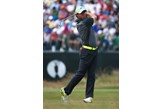5 things Rory does best - that you can do too
Published: Last updated:
The Open 2014 Champion Rory McIlroy is proof that doing the simple things well takes you a long way. His approach to technique, strategy and attitude can move your game to the next level too.
“The genius of Rory’s swing is its simplicity. Simplicity that’s born out of fundamentals, which sadly are considered antiquated in today’s world.” Those words were written earlier by former PGA Tour player Brandel Chamblee, and I couldn’t agree more. Yes, Rory looks magnificent and free-flowing, but there is nothing complicated about him, or the way he plays golf. It’s a great example to follow, because whether you are a Tour pro or a 20-handicapper, if you do the simple things just a little bit better, your golf will improve. Here, I select five aspects of Rory’s game that best exhibit this elementary approach – and from which we can all learn.
#1 Set up for the swing you want to make
Rory moves through such fantastic swing positions because his set-up fundamentals are so orthodox. “We’ve always focused on Rory’s posture, alignment and ball position,” says his one and only coach Michael Bannon. “We keep a constant eye on them.” This is a lesson in itself. But what I really like about Rory’s address position is how well it matches the swing he wants to make. His is a centred swing, powered by a strong and athletic body motion that moves the club fast. His set-up reflects this in two key areas: balance and tone.
Balance
You have to be well balanced to move the club with precision at pace – and Rory’s poise is perfect. At set-up he has “absolute balance”: 50-50 heel-to-toe, 50-50, right-to-left. This grounded feel allows him to make a forceful swing without losing balance.
Tone
Rory looks ready to hit it hard; muscles are primed, but not tensed. If he was wearing shorts you’d see definition in his legs, as they brace to support a hard-hitting motion. The whole tone of his set-up is one of creating and supporting an aggressive motion.
What you can learn
A powerful action depends on good balance. Even knee flex is a simple and effective way to establish a 50-50 right-left split. For heel-toe spread, take up your set-up and ask a friend to push or pull you off-balance. Your point of most resistance is your point of maximum stability. It’s a useful drill for the top of the backswing too, as on the way back weight often moves forward, toes and calves firing like mad to stay balanced – a response to the myth of being on the balls of your feet. I’ll rock the player back and forth until they feel solid. That’s your balance point; how far from the ball are you now? But the wider lesson here is to develop the set-up geometry that matches what you are trying to do with your swing. Establish the action you want to make – aggressive, smooth, rhythmic and so on – and hone the set-up fundamentals that promote that action.
#2 Make Greens In Regulation your best stat
Rory’s best stat also happens to be one of golf’s key performance indicators – Greens in Regulation. Speak to the statistical experts at Golf Data Lab or Strokeaverage.com and they will confirm the importance of raising your GIR. Virtually all serial winners have a great GIR record. One of the Tour players I work with, James Morrison, has lowered his scoring average by half a shot in 2011, simply by raising his GIR figures by 10 per cent.
What you can learn
In order to hit more greens, adopt these four straightforward tactics:
1 Keep a statistical record. Do you know how many greens a round you currently hit? And when you miss them, do you know where? If not, find out; knowing these figures is your first step to finding more greens.
2 Know how far you hit it. Rory could tell you within a yard how far his 6-iron goes. You may not have his consistency, but with just a few smart practice sessions you can still establish accurate parameters for each club.
3 Commit to appropriate clubbing. Picking the right club for the distance will improve your consistency of rhythm… and results.
4 Improve your understanding of the effects of elevation change, wind and temperature. Do this simply by ‘staying awake’. If you are hitting into a one-club wind uphill and end up 25 yards short, don’t blame a random gust; accept you underclubbed, and learn from it.

#3 See disappointment as a learning process
In September 2008, a 19-year-old Rory was poised to win his first European Tour event, leading by four shots coming into the final round of the European Masters. But by the 72nd hole, he faced a five-footer to win. He missed. Then, on the second play-off hole, he missed again from even closer. Just five months later, he was making a nerveless sand save to win in Dubai. “It was tricky up and down,” he said, “I took a few deep breaths and composed myself. It was probably one of the best bunker shots I have ever played.”
This episode was a precursor to 2011’s bounceback. At the Masters Rory shot a final-round 80 after leading by four on Saturday, only to demolish the US Open field two months later. As the world looked for a million scapegoats, Rory himself did the opposite; he took responsibility. “This is my first experience of a Major Sunday,” he said to the media afterwards. “I didn’t handle it particularly well today, obviously, but it was a character-building day, put it that way. I’ll come out stronger for it. Hopefully the next time I’m in this position I’ll be able to handle it a little better.”
What you can learn
It is easy to interpret messing up as failure. But like Rory, you will move forwards when you recognise it’s OK to make mistakes. Once you do that, you can make an honest appraisal of what went wrong, and what you can learn from the experience. Unfortunately many club golfers hit the same bad shot and are too busy beating themselves up for it to get to grips with why it happened, and what can be done to rectify it. Take a leaf from Rory’s book. Face up to “failure”, and learn from it. It’s the hallmark of a champion.
#4 Improve your body action
A good body turn means efficient movement of the club. It keeps the club on plane, influences face position, and affords the correct sequencing for power. Rory’s body pivots are perhaps the purest on Tour, and, along with his set-up lines, the reason he moves through such beautiful positions; great retaining of angles and a powerful X-factor stretch. Underpinning the action are three simple building blocks:
1 Spinal alignment Rory maintains the natural curves of his spine and this neutral spinal alignment offers huge mobility.
2 Footwork Moving into the right side in the backswing and the left in the followthrough is the foundation of a good pivot. Weight shift works in harmony with the direction of rotation.
3 Spine angle consistency Like all top players, he tilts from the hips and simply rotates back and through around that angle. This means consistency in the swing’s plane.
What you can learn
Your body pivot can make or break your swing, but is only as good as your posture; if your posture breaks down, your ability to pivot breaks down. Work on creating that natural, neutral spinal alignment that affords optimal mobility – then on blending your weight shift with your turn. Both lead to an improved body action.
 #5 Know what you need to do… and stick to it
#5 Know what you need to do… and stick to it
Many amateurs see the road to improvement as changing as many things as possible. It’s a flawed concept, leading to a scattergun approach often based on nothing more tangible than what feels good, or right, on the day.
Rory’s approach is pretty much the opposite of this. He still swings the way he did as a 10-year old learning the game. He only changes what is necessary. “I’m a grip-it-and-rip-it guy,” he says. “I’ve always played that way.” Always. It is as if he has said “This is my golf game, these are my characteristics and this is how I’m getting better with them”.
Rory has only ever had one coach – Bangor GC head pro Michael Bannon. One coach means trust and understanding, continuity and focus. Above all, there is no room for a conflict of direction. That continuity paves the way for establishing the truth about your golf game. If you are constantly changing things, you can never get to grips with where your game is; continuity, on the other hand, makes identifying what is needed to get better much easier. On top of this, the pair will use video, statistical analysis or simply performance to make sure any changes are firstly the right ones, and then pursued with focus and strategy.
What you can learn
If you are serious about improving, follow Rory’s example:
1 Commit to a policy of only making changes to your technique or approach for a reason.
2 Find a coach you can trust, and stick with them.
3 Find out the truth about your game through video, statistics, or paying closer attention to your performance.
4 Identify the area that is having the most significant impact on your score.
5 Agree a strategy to tackle it – but accept the responsibility for getting better lies with you alone.









 #5 Know what you need to do… and stick to it
#5 Know what you need to do… and stick to it